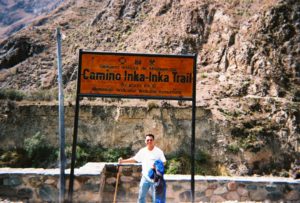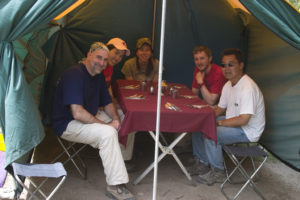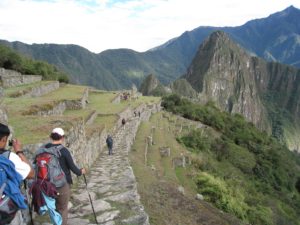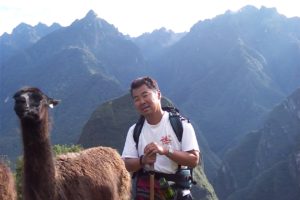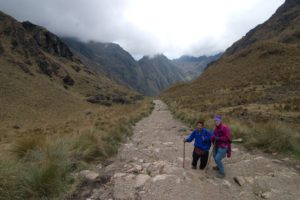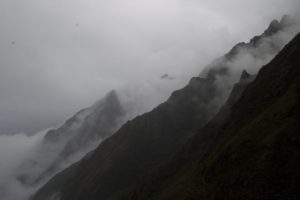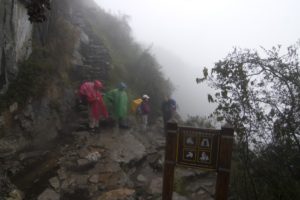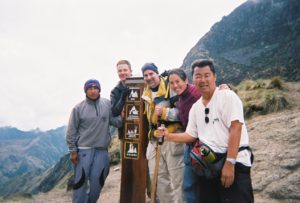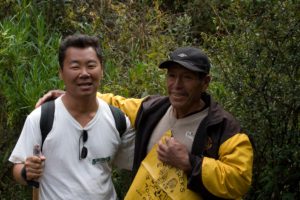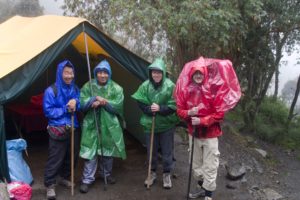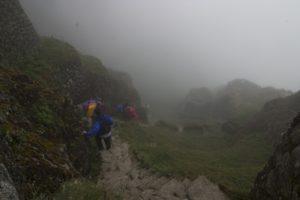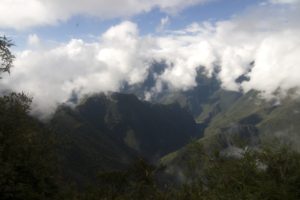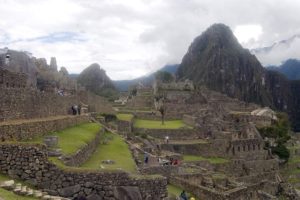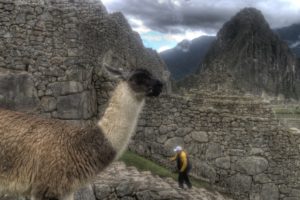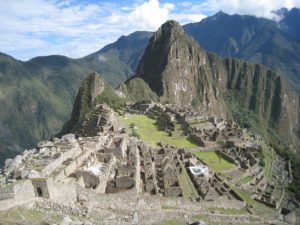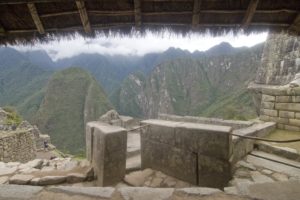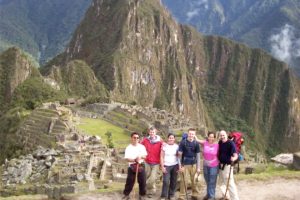Cuzco, Peru — There are two ways to get to Machu Picchu. You can take a train and the tourist bus which is the easy way or you can spend four days trekking the Inca Trail through the Andes which is the hard way. Perhaps I drank too many pisco sours in Lima, but for whatever reason, I chose to do it the hard way. It turned out to be the most physically challenging thing I’ve ever done in my life. No amount of preparation can ever fully prepare you for the steepness of those mountains or the thin Andean air.
Day One: We begin our trek. I am joined by a nice Australian couple, who seem to enjoy my stories of Hollywood celebrity sightings and three friends from Chicago. One of them is a Taiwanese American. She is a little bossy and demanding. Being the only two Asian Americans on the trek we get along fine, but I know my more laid back west coast personality might drive her crazy. The trek is long, six hours carrying a heavy pack . Toilet facilities along the trail are few and primitive, usually a hole in the ground. You must bring your own toilet paper, because there is none. If you need to wipe, you must dispose of the paper in the trash not the toilet. Plumbing in many third world countries like Peru is not strong enough to flush down paper. A few people from other tour groups decide to turn around and go back. The trek is too hard for them. It’s hard for me too, but I keep going. My water supply is running low. I fear dehydration. My legs are starting to cramp, but I make it to camp. My reward — I get to sleep on the hard ground in my five star tent.
Day Two: Absolutely the most brutal, punishing day I´ve ever experienced. Pure hell, straight up a mountain 4,243 meters, then down into a deep valley. They call this section, “Dead Man´s Pass.¨” I’m getting headaches and dizziness from the thin Andean air. Some people get nose bleeds. All I can do is take it a few meters at a time, then try to catch my breath. All I can think of are all those stupid inspirational slogans like, “Slow and steady wins the race, and It´s not the destination. It´s the journey.¨ They are not inspiring me. Going down is even harder, because the trail is mostly rocky. Unlike soft ground, hard landings are painful and put a lot of stress on my knees and shins. I am the last of my group to make it to camp that day. When I finally arrive, they all ask me how do I feel? “I could really use a cigarette right now.” I joke. The others laugh, but my whole body aches. It feels like I got my ass kicked several times today.
Day Three: I get smart and hire a porter to help carry some of my stuff. The porters are Quechua Indians who farm in the area and earn extra money by working as porters for tour groups. They have amazing strength and stamina and can move swiftly up and down these mountains, carrying large amounts of weight on their backs, including heavy propane tanks which are used for cooking and heating. The lead porter is a guy everyone calls, “Black Eagle.¨He looks really tough and you can tell he’s been doing these treks for years. My stamina is much better today, but it rains. I can´t believe how high we are in these mountains. It feels like I’m walking in the clouds. The rocks are wet and slippery. A bad slip could mean serious injury–even death. I just try to stay focused and move ahead slowly one step at a time. I think a lot about my friend Gilbert who died a few years ago. He and I used to talk about doing stuff like this together when we were younger. It makes me sad to think that I made it here and he didn’t. I finally make it to camp early in the evening. A small reward–they have hot showers here.
Day Four: The last day. We rise at 4:00 am. We need to get to Machu Picchu before the tourist buses arrive. It´s still dark outside and chilly. My left leg hurts. I have trouble keeping pace. Luckily we get a break in the weather. The sun comes out. Weather in the Andes can be very unpredictable. We make it to the Gate of the Sun, which is an observatory the Incas created to study the planets and the stars. You can see Machu Picchu from here. It’s a clear day. About 45 minutes later we arrive at the entrance. Machu Picchu is magnificent. Pictures could never truly describe this place or do it justice. I try to take it all in and enjoy the moment. Around noon or so, the tourists start to arrive. It becomes crowded and starts to rain. I decide it´s time to leave. I take the tourist bus back into town and then later rejoin the others in my group. We soak our sore and tired bodies at the local hot springs and then take the train back to Cuzco. Everyone in our group completed the trek. It feels satisfying.
It´s all just sinking in now. The journey and what did it mean for me? By the way, what took us four days to complete, the record is held by a few of those Quechua Indian porters, who completed the trek in just over three and a half hours!
Tip: If you plan to trek the Inca Trail, arrive in Cuzco at least 3-4 days early and allow your body to acclimate to the higher altitude.
The company I booked my trek with is Peru Treks. They will supply all the tents, food, porters and whatever else you need.
